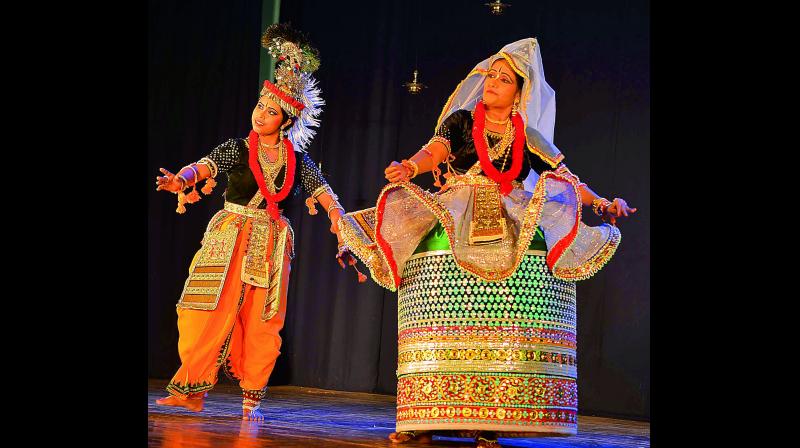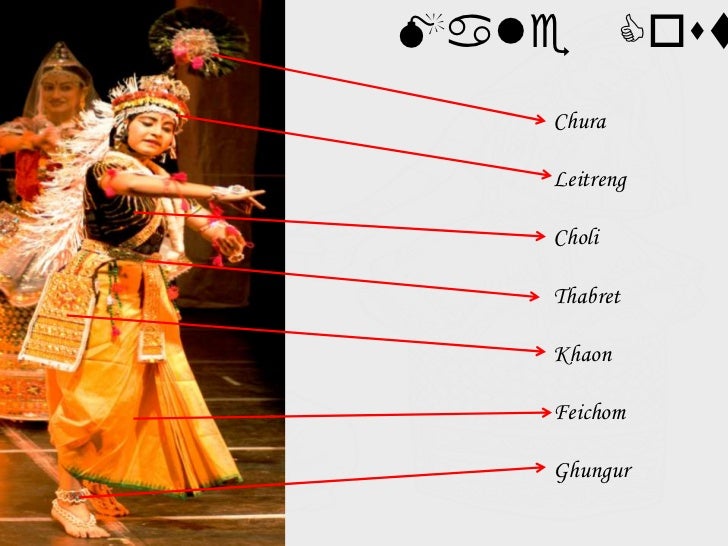MANIPURI

Manipuri dance, also known as Jagoi, is one of the major Indian classical dance forms, named after the region of its origin – Manipur, a state in northeastern India bordering with Myanmar (Burma), Assam, Nagaland and Mizoram. It is particularly known for its Hindu Vaishnavism themes, and exquisite performances of love-inspired dance drama of Radha-Krishna called Raslila. However, the dance is also performed to themes related to Shaivism, Shaktism and regional deities such as Umang Lai during Lai Haraoba.
The Manipuri dance is a team performance, with its own unique costumes, aesthetics, conventions and repertoire. The Manipuri dance drama is, for most part, marked by a performance that is graceful, fluid, sinuous with greater emphasis on hand and upper body gestures.
Manipuri dance is a religious art and its aim is the expression of spiritual values. Aspects of this performance art is celebrated during Hindu festivals and major rites of passage such as weddings among the Manipuri people, particularly in the ethnic majority of Meitei people. The dance drama choreography shares the plays and stories of 'Vaishnavite Padavalis', that also inspired the major Gaudiya Vaishnava-related performance arts found in Assam and West Bengal.
HISTORY


The roots of Manipuri dance, as with all classical Indian dances, is the ancient Hindu Sanskrit text Natya Shastra, with influences and the culture fusion between various local folk dance forms. According to the traditional legend, the indigenous people of the Manipur valley were the dance-experts revered as Gandharvas in the Hindu epics (Ramayana and Mahabharata), suggesting a dance tradition has existed in Manipur since antiquity. With evidence of Vishnu temples in the medieval era, the dance arts have been passed down verbally from generation to generation as an oral tradition. The first reliably dated written texts describing the art of Manipuri dance are from the early 18th-century.
REPERTOIRE
The traditional Manipuri dance style embodies delicate, lyrical and graceful movements. The dance features rounded soft sensuous movements of women, and occasional fast movements by male characters. Unlike other classical Indian dances with religious themes, the Manipuri dance artists do not wear anklet bells and the footwork is subdued and gentle in the Manipuri style. The stage movements is part of a composite movement of the whole body.
Chali or Chari is the basic dance movement in Manipuri Ras dances. The repertoire and underlying play depends on the season. The dances are celebrated on full moon nights, three times in autumn (August through November) and once again in spring (March or April). The Vasant Ras is timed with the Hindu festival of colors called Holi, while others are timed with post-harvest festivals of Diwali and others. The plays and songs recited during the dance performance center around the love and frolics between Radha and Krishna, in the presence of Gopis named Lalita, Vishakha, Chitra, Champaklata, Tungavidya, Indurekha, Rangadevi and Sudevi. There is a composition and dance sequence for each Gopi, and the words have two layers of meanings, one literal and other spiritual. The longest piece of the play focuses on Radha and Krishna. The dancer playing Krishna expresses emotions, while the body language and hand gestures of the Gopi display their feelings such as longing, dejection or cheer.
COSTUMES

The classical Manipuri dance features unique costumes. The women characters are dressed like a Manipuri bride, in Potloi costumes, of which the most notable is the Kumil. A Kumil is an elaborately decorated barrel shaped long skirt stiffened at the bottom and close to the top. The decorations on the barrel include gold and silver embroidery, small pieces of mirrors, and border prints of lotus, Kwaklei orchid, and other items in nature. The Kumil may be an adaptation of Fanek (or Phanek) – a tighter sarong-like wear which is used in more vigorous dances and by male characters. The Kumil is bordered at the top with undulating gauzy translucent top skirt shaped like an open flower, and tied in Trikasta or three places around the waist (front, back and one side) with spiritual symbolism of the ancient Hindu texts. The upper body is dressed in a velvet blouse, the head covered in a white translucent veil, to symbolically mark elusiveness. The dancers do not wear bells on ankles as in other classical Indian dances, but like them Manipuri dance artists do adorn the face, neck, waist, hands and legs with round jewelry ornaments or flower garlands that flow with the dress symmetry. The symmetrical translucent dress, states Reginald Massey, makes "the dancers appear to float on the stage, as if from another world".
The male characters dress in a dhoti (also called dhotra or dhora) – a brilliantly colored broadcloth pleated, wrapped and tied at waist and allowing complete freedom of movement for the legs. The Krishna character wears a peacock feather containing crown, with a feathery attachment at the back.

No comments:
Post a Comment